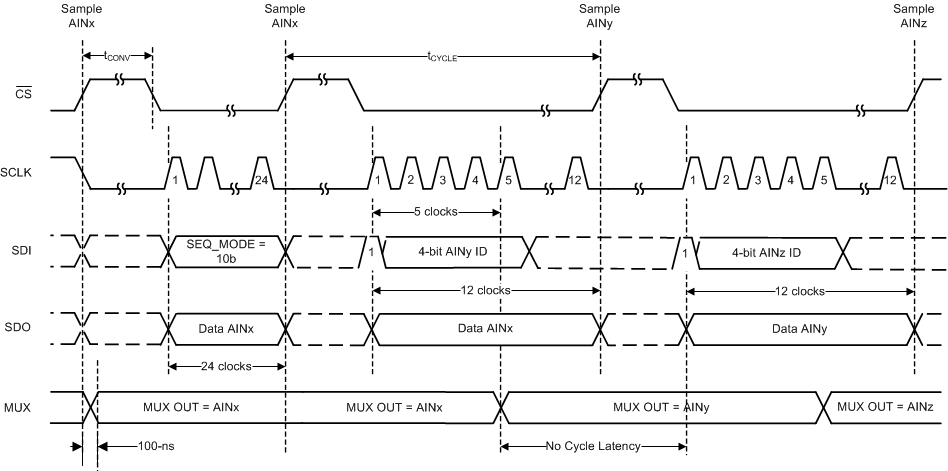SBAS980B June 2019 – June 2020 TLA2518
PRODUCTION DATA.
- 1 Features
- 2 Applications
- 3 Description
- 4 Revision History
- 5 Pin Configuration and Functions
- 6 Specifications
-
7 Detailed Description
- 7.1 Overview
- 7.2 Functional Block Diagram
- 7.3 Feature Description
- 7.4 Device Functional Modes
- 7.5
TLA2518 Registers
- 7.5.1 SYSTEM_STATUS Register (Address = 0x0) [reset = 0x81]
- 7.5.2 GENERAL_CFG Register (Address = 0x1) [reset = 0x0]
- 7.5.3 DATA_CFG Register (Address = 0x2) [reset = 0x0]
- 7.5.4 OSR_CFG Register (Address = 0x3) [reset = 0x0]
- 7.5.5 OPMODE_CFG Register (Address = 0x4) [reset = 0x0]
- 7.5.6 PIN_CFG Register (Address = 0x5) [reset = 0x0]
- 7.5.7 GPIO_CFG Register (Address = 0x7) [reset = 0x0]
- 7.5.8 GPO_DRIVE_CFG Register (Address = 0x9) [reset = 0x0]
- 7.5.9 GPO_VALUE Register (Address = 0xB) [reset = 0x0]
- 7.5.10 GPI_VALUE Register (Address = 0xD) [reset = 0x0]
- 7.5.11 SEQUENCE_CFG Register (Address = 0x10) [reset = 0x0]
- 7.5.12 CHANNEL_SEL Register (Address = 0x11) [reset = 0x0]
- 7.5.13 AUTO_SEQ_CH_SEL Register (Address = 0x12) [reset = 0x0]
- 8 Application and Implementation
- 9 Power Supply Recommendations
- 10Layout
- 11Device and Documentation Support
- 12Mechanical, Packaging, and Orderable Information
Package Options
Mechanical Data (Package|Pins)
- RTE|16
Thermal pad, mechanical data (Package|Pins)
- RTE|16
Orderable Information
7.4.3 On-the-Fly Mode
In the on-the-fly mode of operation, the analog input channel is selected, as shown in Figure 32, using the first five bits on SDI without waiting for the CS rising edge. Thus, the ADC samples the newly selected channel on the CS edge and there is no latency between the channel selection and the ADC output data.
 Figure 32. Starting Conversions and Reading Data in On-the-Fly Mode
Figure 32. Starting Conversions and Reading Data in On-the-Fly Mode The number of clocks required for reading the output data depends on the device output data frame size; see the Output Data Format section for more details.